Streamflow of the Betwa River under the Combined Effect of LU-LC and Climate Change
Abstract
1. Introduction
2. Materials and Methods
2.1. Study Area
2.2. Datasets
2.2.1. Hydrometeorological
2.2.2. Satellite
2.3. Processing
2.3.1. Climate Data
2.3.2. LU-LC Classification
2.4. LU-LC Change Modeling
2.5. Hydrological Model Set Up
3. Results
3.1. Sensitivity and Performance Analysis
3.2. Observed and Projected LULC
3.3. Hydro-Climatic Variability
3.4. Streamflow under LU-LC and Climate Change
4. Discussion
5. Conclusions
- A transition from wetter to drier hydro-climatic conditions is evident in the upper Betwa River catchment, which affects the streamflow of the catchment.
- The combined effect of climate and LU-LC change has resulted in the mean monsoon streamflow of Betwa River to decrease by 16% during 2001–2020 as compared to 1982–2000.
- The mean monsoon streamflow is likely to decrease in all four future climate scenarios. It is projected to decrease by about 39–47% (2023-2060) and 31–41% (2061–2100) in the catchment with respect to the streamflow values observed during 1982–2020.
- Water scarcity in the catchment is likely to aggravate due to landuse modification and climate change under four different CMIP6 future climate scenarios.
Author Contributions
Funding
Institutional Review Board Statement
Data Availability Statement
Acknowledgments
Conflicts of Interest
References
- Cosgrove, W.J.; Loucks, D.P. Water management: Current and future challenges and research directions. Water Resour. Res. 2015, 51, 4823–4839. [Google Scholar] [CrossRef]
- Huang, J.; Tagawa, K.; Wang, B.; Wen, J.; Wang, J. Seasonal Surface Runoff Characteristics in the Semiarid Region of Western Heilongjiang Province in Northeast China—A Case of the Alun River Basin. Water 2019, 11, 557. [Google Scholar] [CrossRef]
- Singh, P.K.; Chudasama, H. Pathways for climate change adaptations in arid and semi-arid regions. J. Clean. Prod. 2021, 284, 124744. [Google Scholar] [CrossRef]
- Marhaento, H.; Booij, M.J.; Hoekstra, A.Y. Hydrological response to future land-use change and climate change in a tropical catchment. Hydrol. Sci. J. 2018, 63, 1368–1385. [Google Scholar] [CrossRef]
- Tian, J.; Guo, S.; Yin, J.; Pan, Z.; Xiong, F.; He, S. Quantifying both climate and land use/cover changes on runoff variation in Han River basin, China. Front. Earth Sci. 2022, 1–23. [Google Scholar] [CrossRef]
- Nayak, S. Land use and land cover change and their impact on temperature over central India. Lett. Spat. Resour. Sci. 2021, 14, 129–140. [Google Scholar] [CrossRef]
- Roxy, M.K.; Ghosh, S.; Pathak, A.; Athulya, R.; Mujumdar, M.; Murtugudde, R.; Terray, P.; Rajeevan, M. A threefold rise in widespread extreme rain events over central India. Nat. Commun. 2017, 8, 708. [Google Scholar] [CrossRef]
- Paul, S.; Ghosh, S.; Oglesby, R.; Pathak, A.; Chandrasekharan, A.; Ramsankaran, R. Weakening of Indian summer monsoon rainfall due to changes in land use land cover. Sci. Rep. 2016, 6, 2016. [Google Scholar] [CrossRef]
- Islam, A.; Sikka, A.K.; Saha, B.; Singh, A. Streamflow response to climate change in the Brahmani River Basin, India. Water Resour. Manag. 2012, 26, 1409–1424. [Google Scholar] [CrossRef]
- Chawla, I.; Mujumdar, P. Isolating the impacts of land use and climate change on streamflow. Hydrol. Earth Syst. Sci. 2015, 19, 3633–3651. [Google Scholar] [CrossRef]
- Vandana, K.; Islam, A.; Sarthi, P.P.; Sikka, A.K.; Kapil, H. Assessment of potential impact of climate change on streamflow: A case study of the Brahmani River basin, India. J. Water Clim. Chang. 2019, 10, 624–641. [Google Scholar] [CrossRef]
- Hung, C.L.J.; James, L.A.; Carbone, G.J.; Williams, J.M. Impacts of combined land-use and climate change on streamflow in two nested catchments in the Southeastern United States. Ecol. Eng. 2020, 143, 105665. [Google Scholar] [CrossRef]
- Sinha, R.K.; Eldho, T.; Subimal, G. Assessing the impacts of historical and future land use and climate change on the streamflow and sediment yield of a tropical mountainous river basin in South India. Environ. Monit. Assess. 2020, 192, 679. [Google Scholar] [CrossRef] [PubMed]
- Dubey, S.K.; Sharma, D.; Babel, M.S.; Mundetia, N. Application of hydrological model for assessment of water security using multi-model ensemble of CORDEX-South Asia experiments in a semi-arid river basin of India. Ecol. Eng. 2020, 143, 105641. [Google Scholar] [CrossRef]
- Desai, S.; Singh, D.; Islam, A.; Sarangi, A. Impact of climate change on the hydrology of a semi-arid river basin of India under hypothetical and projected climate change scenarios. J. Water Clim. Chang. 2021, 12, 969–996. [Google Scholar] [CrossRef]
- Kumar, N.; Tischbein, B.; Kusche, J.; Laux, P.; Beg, M.K.; Bogardi, J.J. Impact of climate change on water resources of upper Kharun catchment in Chhattisgarh, India. J. Hydrol. Reg. Stud. 2017, 13, 189–207. [Google Scholar] [CrossRef]
- Nilawar, A.P.; Waikar, M.L. Impacts of climate change on streamflow and sediment concentration under RCP 4.5 and 8.5: A case study in Purna river basin, India. Sci. Total. Environ. 2019, 650, 2685–2696. [Google Scholar] [CrossRef]
- Bisht, D.S.; Mohite, A.R.; Jena, P.P.; Khatun, A.; Chatterjee, C.; Raghuwanshi, N.S.; Singh, R.; Sahoo, B. Impact of climate change on streamflow regime of a large Indian river basin using a novel monthly hybrid bias correction technique and a conceptual modeling framework. J. Hydrol. 2020, 590, 125448. [Google Scholar] [CrossRef]
- Gosain, A.; Rao, S.; Basuray, D. Climate change impact assessment on hydrology of Indian river basins. Curr. Sci. 2006, 90, 346–353. [Google Scholar]
- Kumar, A.; Singh, A.; Gaurav, K. Assessing the synergic effect of land use and climate change on the upper Betwa River catchment in Central India under present, past, and future climate scenarios. Environ. Dev. Sustain. 2022, 1–22. [Google Scholar] [CrossRef]
- Pandey, R.; Mishra, S.K.; Singh, R.; Ramasastri, K. Streamflow drought severity analysis of Betwa river system (India). Water Resour. Manag. 2008, 22, 1127–1141. [Google Scholar] [CrossRef]
- Pai, D.; Rajeevan, M.; Sreejith, O.; Mukhopadhyay, B.; Satbha, N. Development of a new high spatial resolution (0.25 × 0.25) long period (1901–2010) daily gridded rainfall data set over India and its comparison with existing data sets over the region. Mausam 2014, 65, 1–18. [Google Scholar] [CrossRef]
- Srivastava, A.; Rajeevan, M.; Kshirsagar, S. Development of a high resolution daily gridded temperature data set (1969–2005) for the Indian region. Atmos. Sci. Lett. 2009, 10, 249–254. [Google Scholar] [CrossRef]
- Hersbach, H.; Bell, B.; Berrisford, P.; Hirahara, S.; Horányi, A.; Muñoz-Sabater, J.; Nicolas, J.; Peubey, C.; Radu, R.; Schepers, D.; et al. The ERA5 global reanalysis. Q. J. R. Meteorol. Soc. 2020, 146, 1999–2049. [Google Scholar] [CrossRef]
- Tatebe, H.; Watanabe, M. MIROC MIROC6 model output prepared for CMIP6 CMIP historical. Earth Syst. Grid Fed. 2018, 10. [Google Scholar] [CrossRef]
- Boucher, O.; Denvil, S.; Caubel, A.; Foujols, M. IPSL IPSL-CM6A-LR Model Output Prepared for CMIP6 CMIP. Earth System Grid Federation. 2018. Available online: https://doi.org/10.22033/ESGF/CMIP6.1534 (accessed on 22 March 2020).
- Bentsen, M.; Jan Leo, O.; Seland, Ø.; Toniazzo, T.; Gjermundsen, A.; Graff, L.S.; Debernard, J.B.; Gupta, A.K.; He, Y.; Kirkevåg,, A.; et al. NCC NorESM2-MM model output prepared for CMIP6 CMIP. Earth Syst. Grid Fed. 2019. [Google Scholar] [CrossRef]
- Eyring, V.; Bony, S.; Meehl, G.A.; Senior, C.A.; Stevens, B.; Stouffer, R.J.; Taylor, K.E. Overview of the Coupled Model Intercomparison Project Phase 6 (CMIP6) experimental design and organization. Geosci. Model Dev. 2016, 9, 1937–1958. [Google Scholar] [CrossRef]
- Iglewicz, B.; Hoaglin, D.C. How to Detect and Handle Outliers; American Society for Quality Control: Milwaukee, WI, USA, 1993; Volume 16. [Google Scholar]
- Hazarika, J.; Sarma, A.K. Importance of regional rainfall data in homogeneous clustering of data-sparse areas: A study in the upper Brahmaputra valley region. Theor. Appl. Climatol. 2021, 145, 1161–1175. [Google Scholar] [CrossRef]
- Mann, H.B. Nonparametric tests against trend. Econom. J. Econom. Soc. 1945, 13, 245–259. [Google Scholar] [CrossRef]
- Gocic, M.; Trajkovic, S. Analysis of changes in meteorological variables using Mann-Kendall and Sen’s slope estimator statistical tests in Serbia. Glob. Planet. Chang. 2013, 100, 172–182. [Google Scholar] [CrossRef]
- Kumar, A.; Sarthi, P.P.; Kumari, A. Observed rainfall events and outgoing longwave radiation over contrasting river basins in Bihar, India. Mausam 2022, 73, 273–282. [Google Scholar] [CrossRef]
- McKee, T.B.; Doesken, N.J.; Kleist, J. The relationship of drought frequency and duration to time scales. In Proceedings of the 8th Conference on Applied Climatology, Anaheim, CA, USA, 17–22 January 1993; pp. 179–184. [Google Scholar]
- Abbas, S.; Kousar, S. Spatial analysis of drought severity and magnitude using the standardized precipitation index and streamflow drought index over the Upper Indus Basin, Pakistan. Environ. Dev. Sustain. 2021, 23, 15314–15340. [Google Scholar] [CrossRef]
- Hayes, M.J.; Svoboda, M.D.; Wiihite, D.A.; Vanyarkho, O.V. Monitoring the 1996 drought using the standardized precipitation index. Bull. Am. Meteorol. Soc. 1999, 80, 429–438. [Google Scholar] [CrossRef]
- Nalbantis, I.; Tsakiris, G. Assessment of hydrological drought revisited. Water Resour. Manag. 2009, 23, 881–897. [Google Scholar] [CrossRef]
- Randall, D.A.; Wood, R.A.; Bony, S.; Colman, R.; Fichefet, T.; Fyfe, J.; Kattsov, V.; Pitman, A.; Shukla, J.; Srinivasan, J.; et al. Climate Models and Their Evaluation. In Climate Change 2007: The Physical Science Basis. Contribution of Working Group I to the Fourth Assessment Report of the IPCC (FAR); Cambridge University Press: Cambridge, UK, 2007; pp. 589–662. [Google Scholar]
- Legates, D.R. Limitations of climate models as predictors of climate change. Brief Anal. 2002, 396, 1–2. [Google Scholar]
- Saputra, M.H.; Lee, H.S. Prediction of land use and land cover changes for north sumatra, indonesia, using an artificial-neural-network-based cellular automaton. Sustainability 2019, 11, 3024. [Google Scholar] [CrossRef]
- e Silva, L.P.; Xavier, A.P.C.; da Silva, R.M.; Santos, C.A.G. Modeling land cover change based on an artificial neural network for a semiarid river basin in northeastern Brazil. Glob. Ecol. Conserv. 2020, 21, e00811. [Google Scholar] [CrossRef]
- Gómez, D.; Montero, J. Determining the accuracy in image supervised classification problems. In Proceedings of the 7th Conference of the European Society for Fuzzy Logic and Technology (EUSFLAT-2011), Paris, France, 18–22 July 2011. [Google Scholar]
- Cibin, R.; Sudheer, K.; Chaubey, I. Sensitivity and identifiability of stream flow generation parameters of the SWAT model. Hydrol. Process. Int. J. 2010, 24, 1133–1148. [Google Scholar] [CrossRef]
- Jiang, L.; Zhu, J.; Chen, W.; Hu, Y.; Yao, J.; Yu, S.; Jia, G.; He, X.; Wang, A.Z. Identification of Suitable Hydrologic Response Unit Thresholds for SWAT Streamflow Modelling in the Upper Hunhe River Watershed, Notheast China. Chin. Geogr. Sci. 2021, 31, 696–710. [Google Scholar] [CrossRef]
- Abbaspour, K.C. SWAT calibration and uncertainty programs. In A User Manual; Swiss Federal Institute of Aquatic Science and Technology (Eawag): Dübendorf, Switzerland, 2015; pp. 17–66. [Google Scholar]
- Aslam, O.P.M. Influence of cosmic-ray variability on the monsoon rainfall and temperature. J. Atmos. Sol.-Terr. Phys. 2015, 122, 86–96. [Google Scholar]
- Vishnu, S.; Chakraborty, A.; Srinivasan, J. Why the droughts of the Indian summer monsoon are more severe than the floods. Clim. Dyn. 2022, 58, 3497–3512. [Google Scholar] [CrossRef]
- Verma, S.; Bhatla, R.; Shahi, N.; Mall, R. Regional modulating behavior of Indian summer monsoon rainfall in context of spatio-temporal variation of drought and flood events. Atmos. Res. 2022, 274, 106201. [Google Scholar] [CrossRef]
- Palmate, S.S. Modelling spatiotemporal land dynamics for a trans-boundary river basin using integrated Cellular Automata and Markov Chain approach. Appl. Geogr. 2017, 82, 11–23. [Google Scholar] [CrossRef]
- Singh, V.G.; Singh, S.K.; Kumar, N.; Singh, R.P. Simulation of land use/land cover change at a basin scale using satellite data and markov chain model. Geocarto Int. 2022, 14, 1–26. [Google Scholar] [CrossRef]
- Tan, X.; Liu, S.; Tian, Y.; Zhou, Z.; Wang, Y.; Jiang, J.; Shi, H. Impacts of Climate Change and Land Use/Cover Change on Regional Hydrological Processes: Case of the Guangdong-Hong Kong-Macao Greater Bay Area. Front. Environ. Sci. 2022, 9, 783324. [Google Scholar] [CrossRef]
- Mall, R.K.; Singh, R.; Gupta, A.; Srinivasan, G.; Rathore, L. Impact of climate change on Indian agriculture: A review. Clim. Chang. 2006, 78, 445–478. [Google Scholar] [CrossRef]
- Levidow, L.; Zaccaria, D.; Maia, R.; Vivas, E.; Todorovic, M.; Scardigno, A. Improving water-efficient irrigation: Prospects and difficulties of innovative practices. Agric. Water Manag. 2014, 146, 84–94. [Google Scholar] [CrossRef]
- Yu, Z.; Man, X.; Duan, L.; Cai, T. Assessments of impacts of climate and forest change on water resources using swat model in a subboreal watershed in northern da hinggan mountains. Water 2020, 12, 1565. [Google Scholar] [CrossRef]
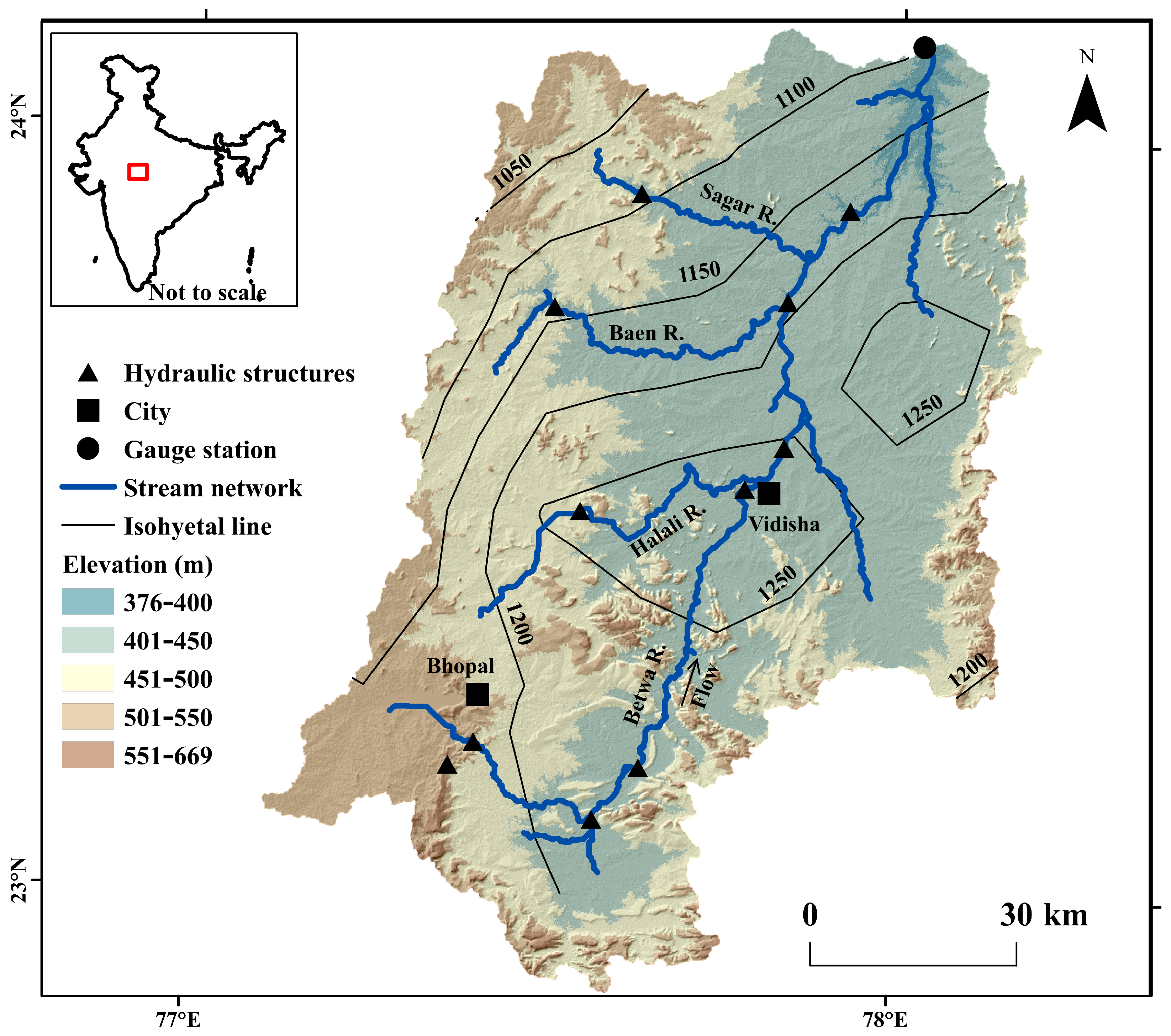
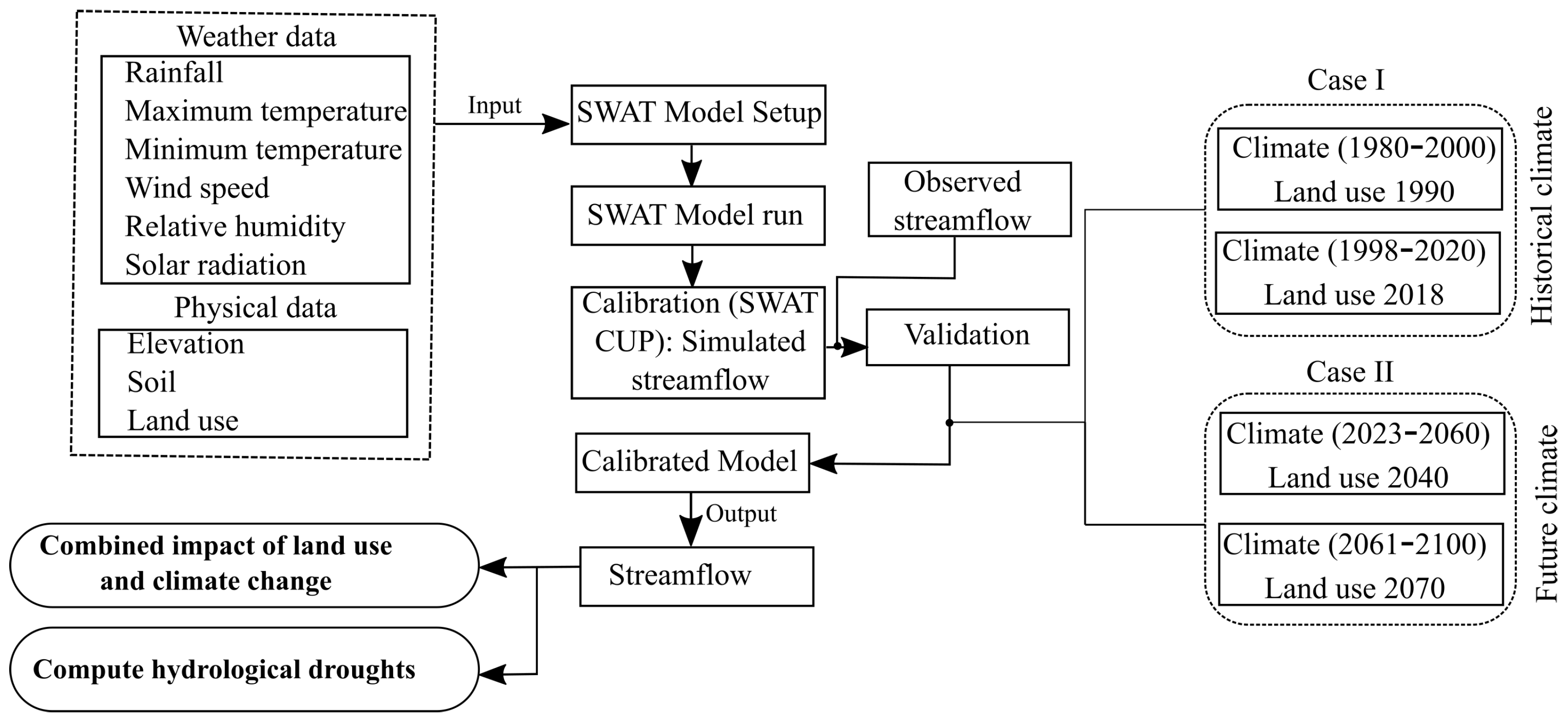
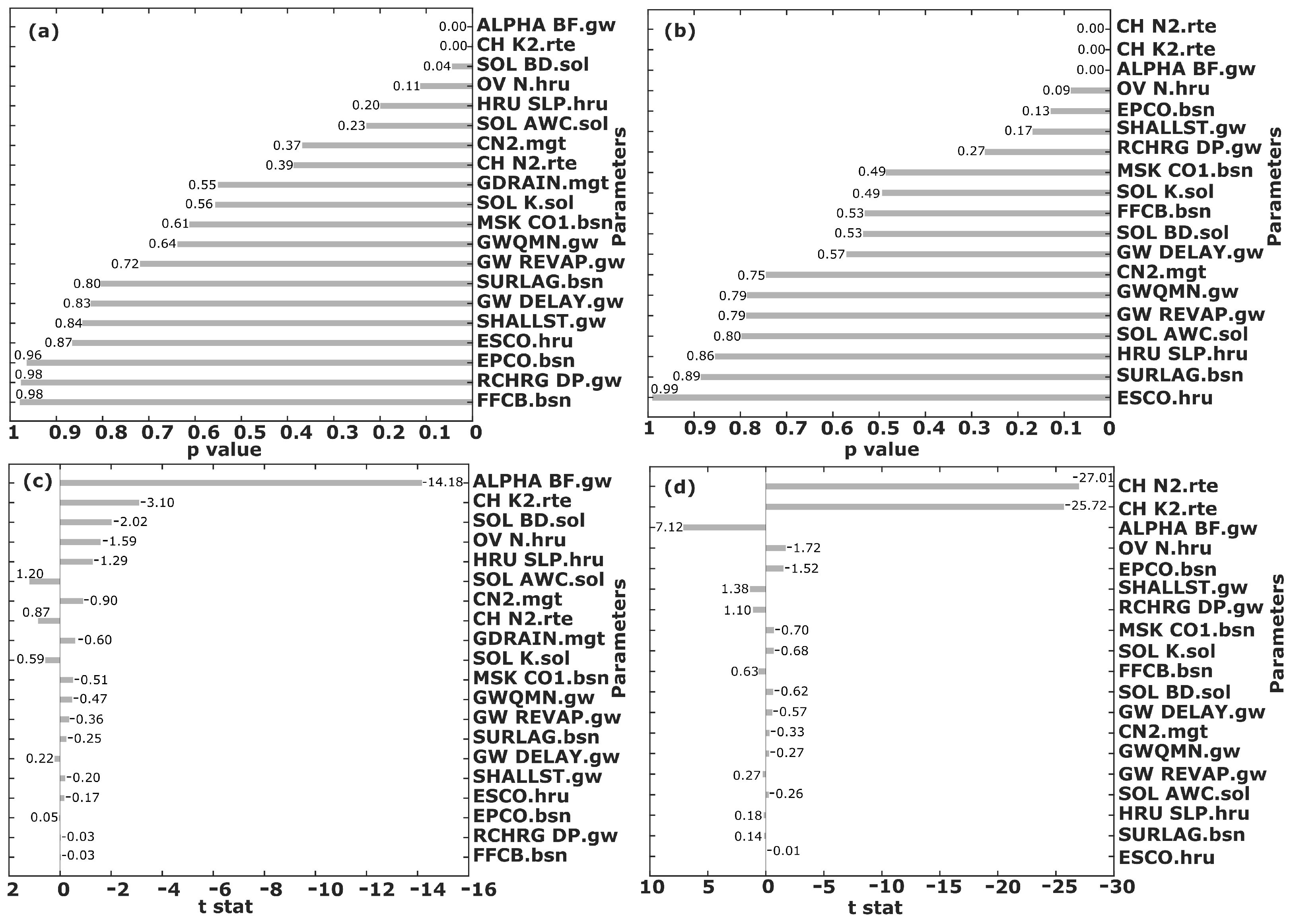

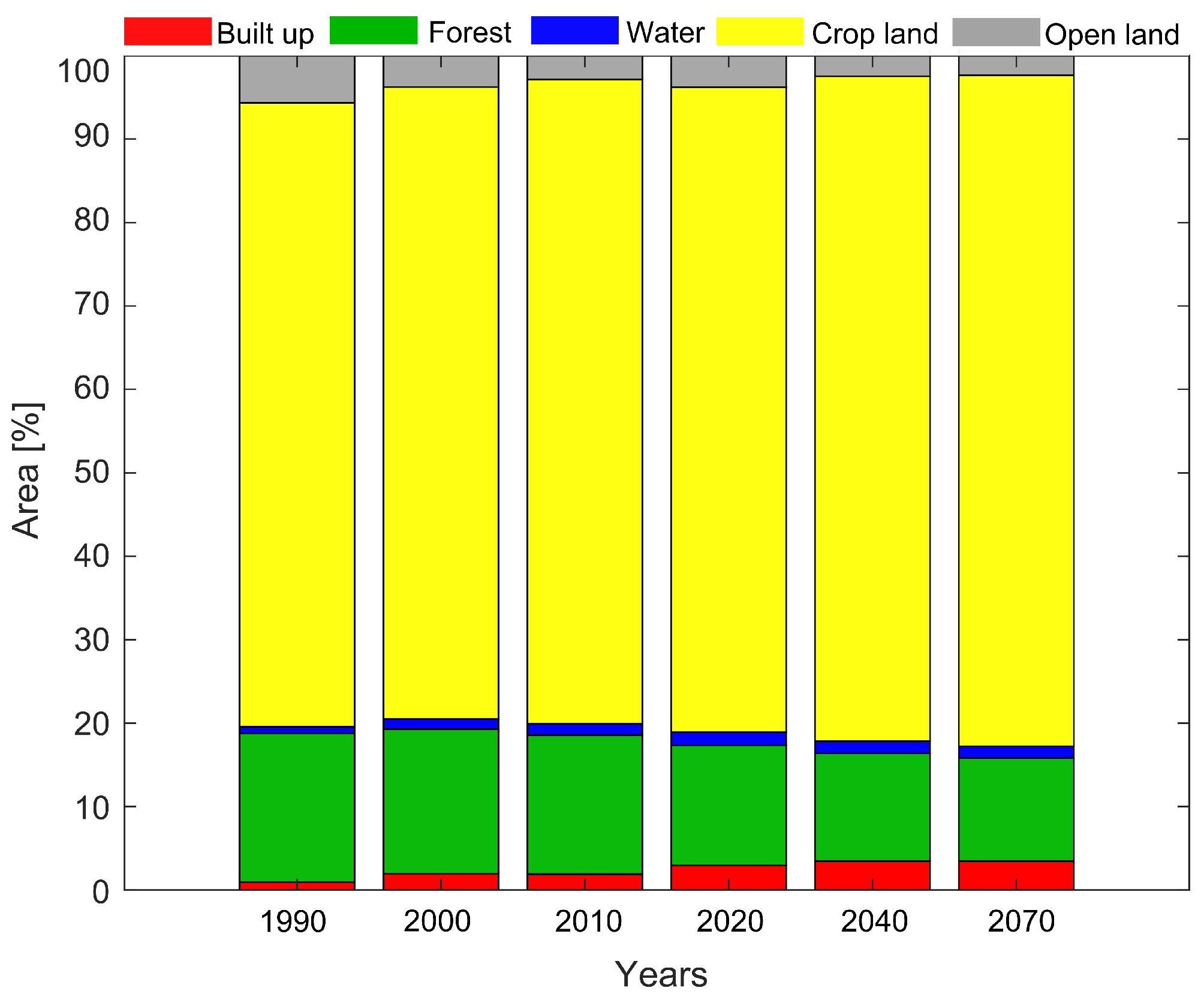
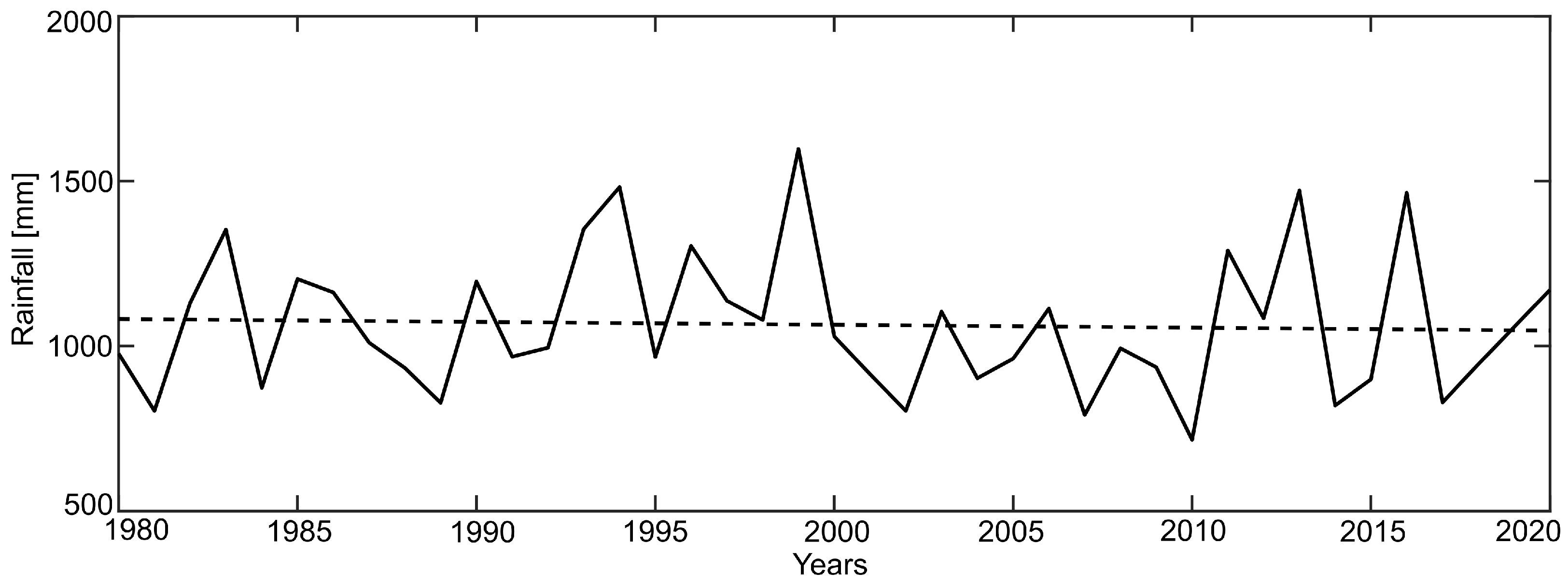

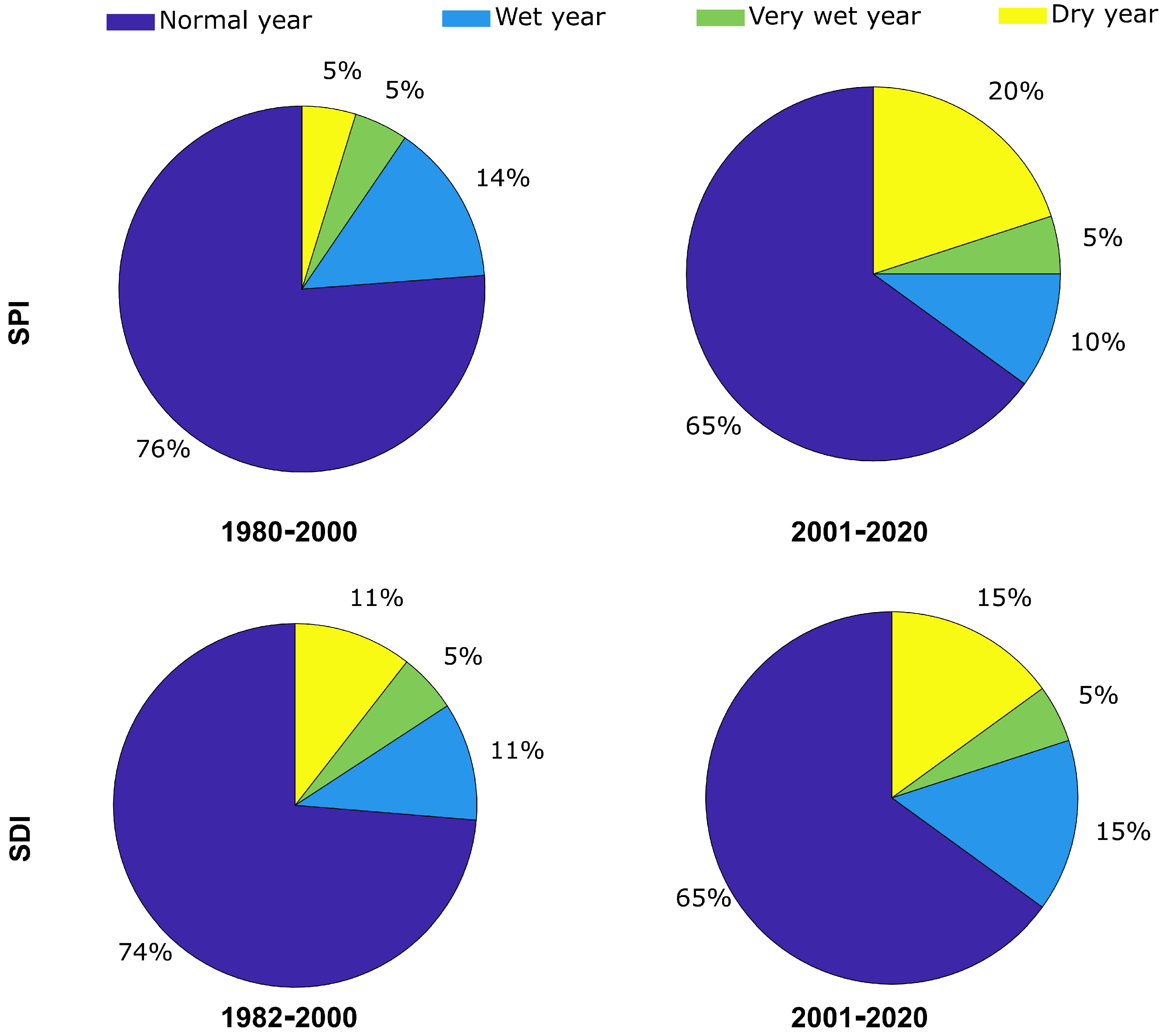

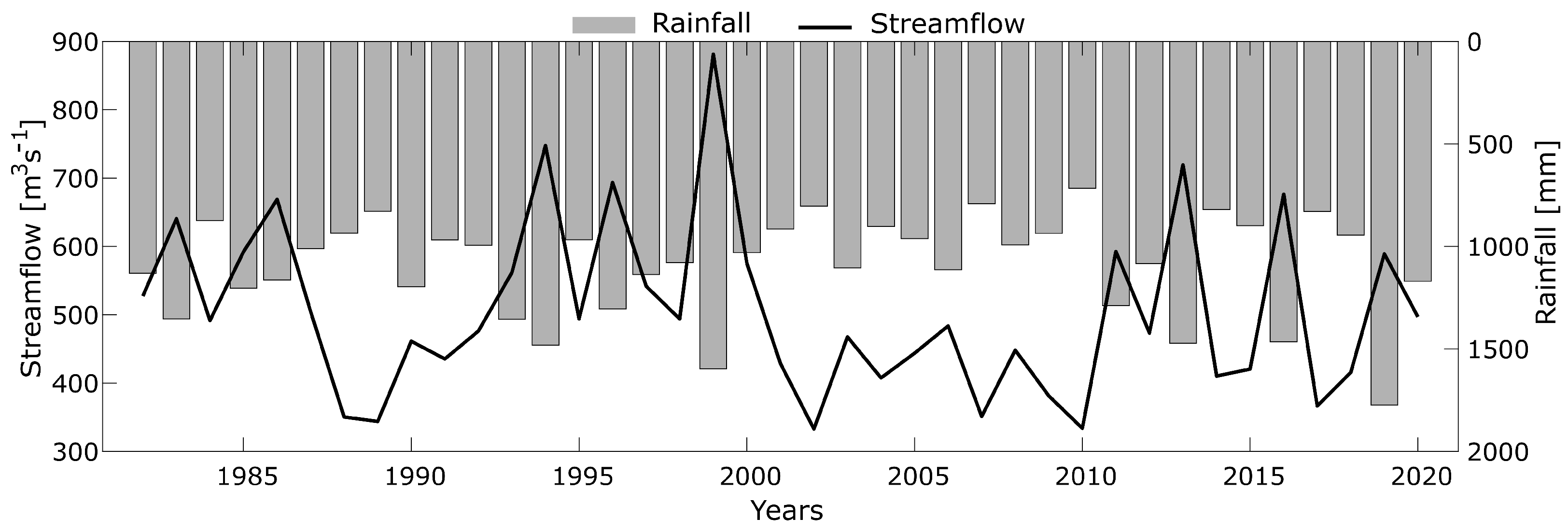
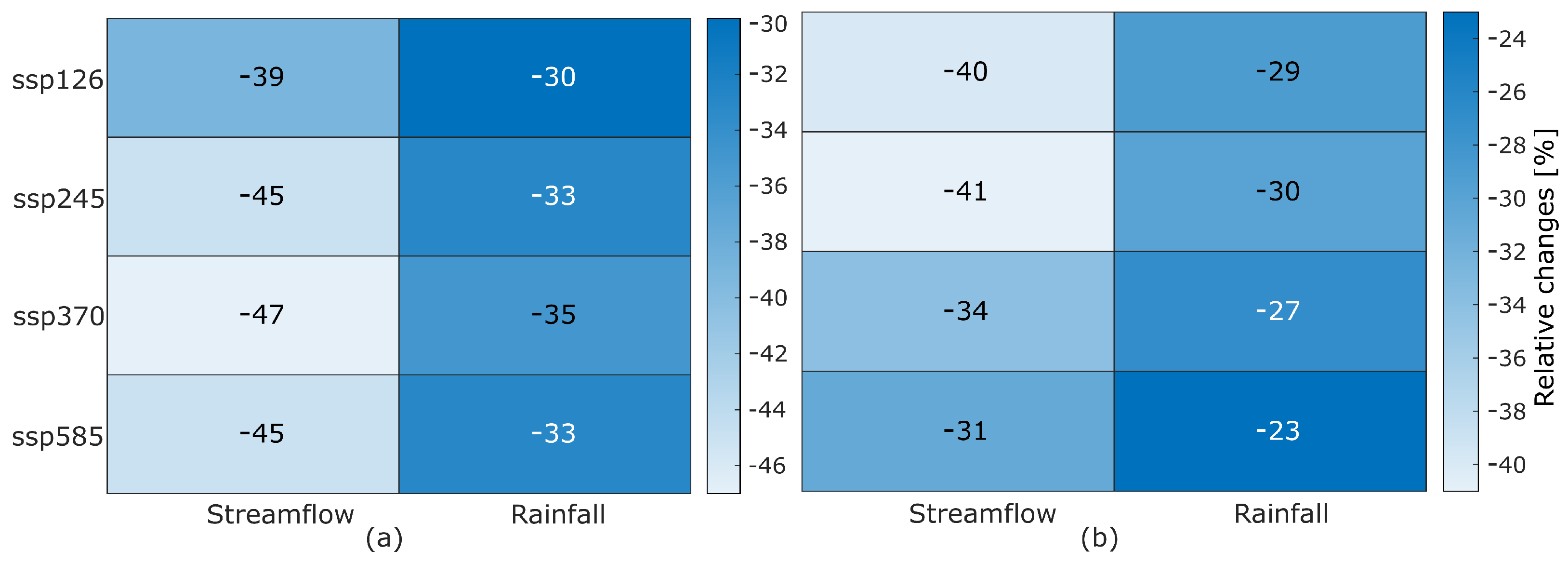
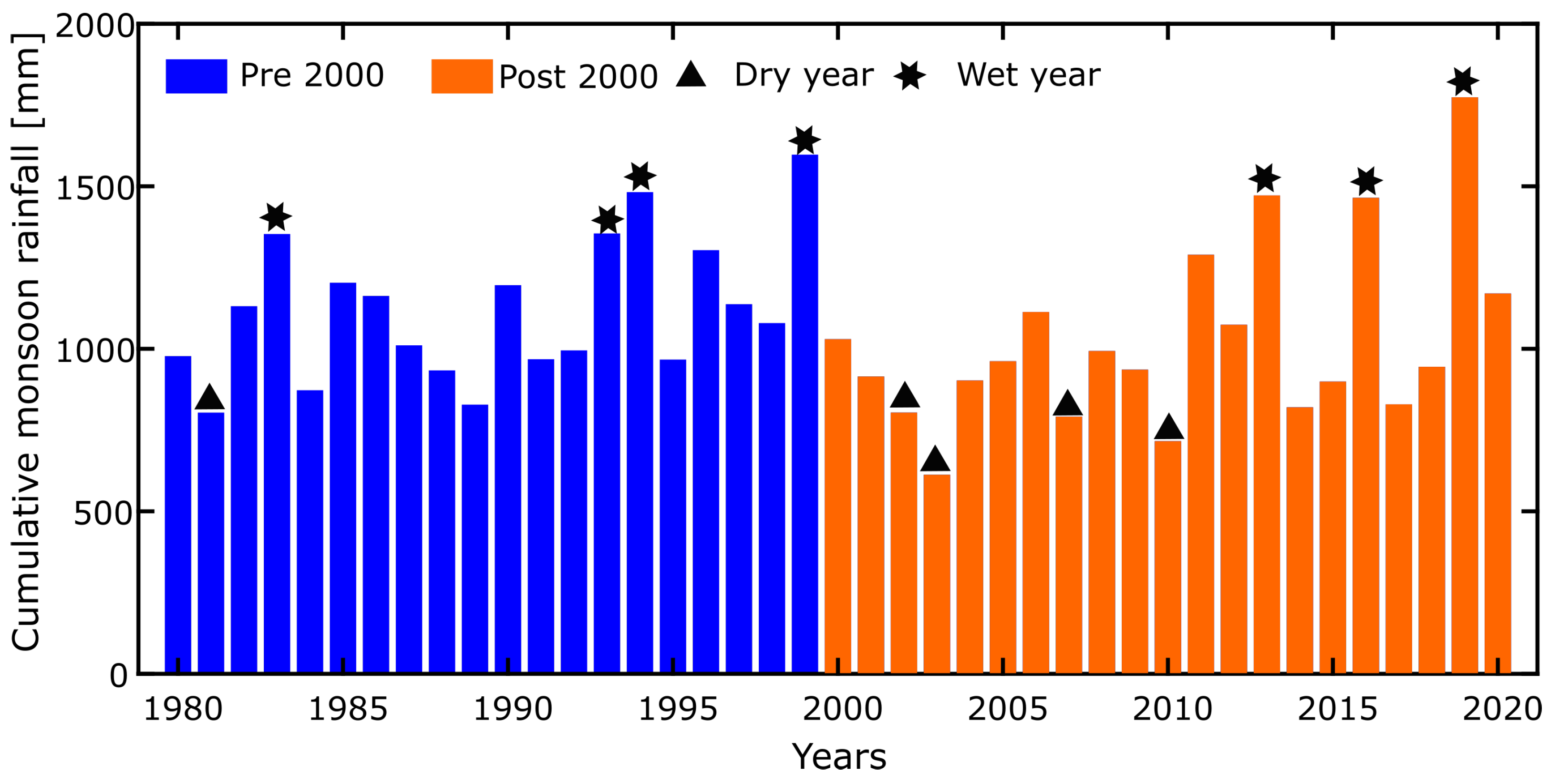
| Data Type | Parameter | Source | Time-Step | Year | Resolution |
|---|---|---|---|---|---|
| Historical climate data | Rainfall | IMD | Daily | 1980–2020 | |
| Wind speed | ERA 5 | Hourly | 1980–2020 | ||
| Minimum and Maximum Temperature | IMD | Daily | 1980–2020 | ||
| Relative humidity | ERA 5 | Hourly | 1980–2020 | ||
| Solar radiation | ERA 5 | Hourly | 1980–2020 | ||
| Future climate data | Rainfall | IPSL-CM6A-LR MIROC 6 NorESM2-MM | Daily | 1980–2100 | |
| Temperature | IPSL-CM6A-LR MIROC 6 NorESM2-MM | Daily | 1980–2100 | ||
| Physical data | Soil map | FAO | - | 1 km | |
| Land use map | Landsat5 and 8 | - | 1990–2020 | 30 m | |
| Elevation | SRTM | - | 90 m | ||
| Discharge | In-situ river discharge | Water Resource Department | Daily | 1991–2014 | Daily |
| Satellite Sensor | Path/Row | Acquisition Year | Spatial Resolution |
|---|---|---|---|
| Landsat 5 TM | 145/43 145/44 146/43 146/44 | 1990 2000 2010 | 30 m |
| Landsat 8 OLI | 145/43 145/44 146/43 146/44 | 2018 2020 | 30 m |
| Year | Kappa Statistics | Overall Accuracy |
|---|---|---|
| 1990 | 0.82 | 0.88 |
| 2000 | 0.88 | 0.92 |
| 2010 | 0.87 | 0.91 |
| 2020 | 0.90 | 0.95 |
Publisher’s Note: MDPI stays neutral with regard to jurisdictional claims in published maps and institutional affiliations. |
© 2022 by the authors. Licensee MDPI, Basel, Switzerland. This article is an open access article distributed under the terms and conditions of the Creative Commons Attribution (CC BY) license (https://creativecommons.org/licenses/by/4.0/).
Share and Cite
Kumar, A.; Singh, R.P.; Dubey, S.K.; Gaurav, K. Streamflow of the Betwa River under the Combined Effect of LU-LC and Climate Change. Agriculture 2022, 12, 2005. https://doi.org/10.3390/agriculture12122005
Kumar A, Singh RP, Dubey SK, Gaurav K. Streamflow of the Betwa River under the Combined Effect of LU-LC and Climate Change. Agriculture. 2022; 12(12):2005. https://doi.org/10.3390/agriculture12122005
Chicago/Turabian StyleKumar, Amit, Raghvender Pratap Singh, Swatantra Kumar Dubey, and Kumar Gaurav. 2022. "Streamflow of the Betwa River under the Combined Effect of LU-LC and Climate Change" Agriculture 12, no. 12: 2005. https://doi.org/10.3390/agriculture12122005
APA StyleKumar, A., Singh, R. P., Dubey, S. K., & Gaurav, K. (2022). Streamflow of the Betwa River under the Combined Effect of LU-LC and Climate Change. Agriculture, 12(12), 2005. https://doi.org/10.3390/agriculture12122005







